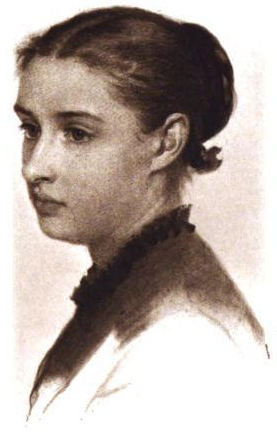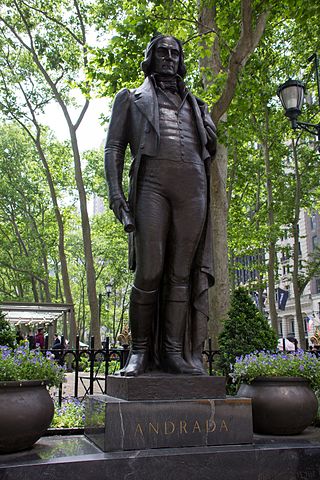
Evelyn Beatrice Longman was an American sculptor whose allegorical figure works were commissioned as monuments and memorials, adornment for public buildings, and attractions at art expositions in the early 20th-century. She became the first woman sculptor to be elected a full member of the National Academy of Design in 1919.

New York City's 843-acre (3.41 km2) Central Park is the home of many works of public art in various media, such as bronze, stone, and tile. Many are sculptures in the form of busts, statues, equestrian statues, and panels carved or cast in low relief. Others are two-dimensional bronze or tile plaques. Some artworks do double-duty as fountains, or as part of fountains; some serve as memorials dedicated to a cause, to notable individuals, and in one case, to a notable animal. Most were donated by individuals or civic organizations; only a few were funded by the city.

Josephine Shaw Lowell was a Progressive Reform leader in the United States in the Nineteenth century. She is best known for creating the New York Consumers League in 1890.

Allen George Newman III was an American sculptor, best known for his statue "The Hiker".

The Burnside Fountain is a non-functioning drinking fountain at the southeast corner of Worcester Common in Worcester, Massachusetts. It consists of two parts, a pink granite basin, and a bronze statue of a young boy riding a sea turtle. The basin was designed by architect Henry Bacon, who later designed the Lincoln Memorial in Washington, D.C., and the figure was created by sculptor Charles Y. Harvey. Harvey died by suicide before finishing the sculpture, and Sherry Fry completed the bronze. The Burnside Fountain was commissioned in 1905 by the city of Worcester after Harriet F. Burnside bequeathed US $5,000 to create a fountain to provide fresh water for people, horses and dogs, in the memory of her father, a prominent lawyer. The fountain was installed in 1912 in Central Square, then moved in 1969 to its current location on Worcester Common. In 1970 the statue was stolen, and was re-installed two years later. An attempted theft occurred in 2004.

A temperance fountain was a fountain that was set up, usually by a private benefactor, to encourage temperance, and to make abstinence from beer possible by the provision of clean, safe, and free water. Beer was the main alternative to water, and generally safer. The temperance societies had no real alternative as tea and coffee were too expensive, so drinking fountains were very attractive.

The Stephenson Grand Army of the Republic Memorial, also known as Dr. Benjamin F. Stephenson, is a public artwork in Washington, D.C. honoring Dr. Benjamin F. Stephenson, founder of the Grand Army of the Republic, a fraternal organization for Union veterans. The memorial is sited at Indiana Plaza, located at the intersection of 7th Street, Indiana Avenue, and Pennsylvania Avenue NW in the Penn Quarter neighborhood. The bronze figures were sculpted by J. Massey Rhind, a prominent 20th-century artist. Attendees at the 1909 dedication ceremony included President William Howard Taft, Senator William Warner, and hundreds of Union veterans.

Vietnam Veterans Plaza is an American memorial plaza in Manhattan, New York. It honors New York City citizens who served during the 20th-century Vietnam War.

George Washington is an outdoor sculpture by Henry Kirke Brown (1814–1886), located in Union Square, Manhattan, in the United States. The bronze equestrian statue was dedicated in 1856 and is the oldest sculpture in the New York City Parks collection. It depicts Washington beginning his triumphant march of the Continental Army through Manhattan on Evacuation Day, November 25, 1783, soon after the British Army had departed New York City.

The 107th Infantry Memorial is an outdoor bronze sculpture and memorial located at the intersection of East 67th Street and Fifth Avenue in Central Park, in Manhattan, New York, United States, which honors members of the 107th Infantry who died during World War I. Created by the sculptor Karl Morningstar Illava (1896–1954), who "drew from his own experience serving as a sergeant with the 107th," according to the New York City Department of Parks & Recreation, the sculpture cost an estimated $60,000 at the time of its construction, depicts the actions of seven World War I-era soldiers, and rests on a 25-foot-wide stepped granite base designed by architects Rogers & Haneman.

José Bonifácio de Andrada e Silva, also known as the Andrada Monument, is an outdoor bronze sculpture of José Bonifácio de Andrada by José Otavio Correia Lima, located at Bryant Park in Manhattan, New York. It is 9 feet (2.7 m) tall and weights approximately 4,000 lbs. Lima was selected through a competition that was sponsored by the Brazilian government, which also donated $60,000 for the surrounding plaza and granite base.

An outdoor bronze portrait bust of German writer Johann Wolfgang von Goethe by sculptor Karl Fischer is installed on the south side of Bryant Park in Manhattan, New York. It is a replica of an iron and copper bust created by Fischer around 1832, the year of Goethe's death. Acquired by the Goethe Society of America in 1987, it was displayed at the Metropolitan Museum of Art until it was relocated to Bryant Park in 1932. Following its installation there, the iron and copper bust was replaced with a bronze casting and dedicated on February 15, 1932. The sculpture was refurbished in 1992 by the Bryant Park Restoration Corporation. The sculpture sits on a Swedish black granite pedestal.

Fountain for Company H, also known as Second Oregon Company Volunteers, is a 1914 fountain and war memorial designed by John H. Beaver, installed in Portland, Oregon's Plaza Blocks, in the United States. Dedicated to the men of Company H of the 2nd Oregon Volunteer Infantry Regiment killed in service during the Spanish–American War, the limestone and bronze memorial was installed in Lownsdale Square in 1914. It is part of the City of Portland and Multnomah County Public Art Collection courtesy of the Regional Arts & Culture Council. The memorial has been included in published walking tours of Portland.

William Tecumseh Sherman, also known as the Sherman Memorial or Sherman Monument, is a sculpture group honoring William Tecumseh Sherman, created by Augustus Saint-Gaudens and located at Grand Army Plaza in Manhattan, New York. Cast in 1902 and dedicated on May 30, 1903, the gilded-bronze monument consists of an equestrian statue of Sherman and an accompanying statue, Victory, an allegorical female figure of the Greek goddess Nike. The statues are set on a Stony Creek granite pedestal designed by the architect Charles Follen McKim.

Union Square Drinking Fountain, also known as James Fountain, is an outdoor bronze sculpture and ornamental fountain by sculptor Adolf von Donndorf and architect J. Leonard Corning, located on the west side of Union Square Park in Manhattan, New York City. Cast in 1881 and dedicated on October 25, 1881, it was donated by Daniel Willis James "to promote public health as well as the virtue of charity". The statuary group includes a standing woman holding a baby in her right arm and a young child at her left side. They are set on an octagonal Swedish red granite pedestal with lion head fountains and basins on four of the sides.

Independence Flagstaff, also known as the Charles F. Murphy Memorial Flagpole, is an outdoor memorial by sculptor Anthony de Francisci, located in Union Square Park in Manhattan, New York, which commemorates the 150th anniversary of the signing of the United States Declaration of Independence. The memorial was cast in 1926 and dedicated on July 4, 1930. It was made of steel, with copper sheathing, and is set on a granite pedestal which includes bronze bas-reliefs and plaques. The monument is in axial alignment with Henry Kirke Brown's statues of George Washington and Abraham Lincoln.

An equestrian statue of Simón Bolívar, sometimes called the Simón Bolívar Monument, is installed in Manhattan's Central Park, in the U.S. state of New York. The memorial features a bronze sculpture by Sally James Farnham resting on a black granite pedestal designed by the firm Clarke and Rapuano. It was cast in 1919, dedicated on April 19, 1921, rededicated on April 19, 1951, and conserved by the Adopt-a-Monument Program in 1988.



















